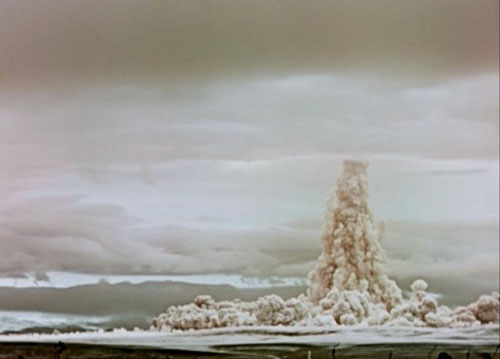Moscow
For decades, footage of history’s most powerful nuclear weapon was kept top-secret. Now, Russia is offering a behind-the-scenes look at the moments leading up to the detonation of that hydrogen bomb, known officially as RDS-220 and informally as Tsar Bomba.
Russia tested Tsar Bomba over a remote archipelago in the Arctic Ocean on October 30, 1961 — during the height of a nuclear arms race with the US. The country declassified documentary footage of that explosion on August 20, in honor of the 75th anniversary of the Russian nuclear industry.
The 40-minute video, uploaded to YouTube, shows the explosion — a blast equivalent to 50 megatons of TNT. That makes it nearly 1,500 times more powerful than the Hiroshima and Nagasaki bombs combined. Russia reported that the flash could be seen from more than 600 miles away.
The video starts as the bomb is transported by rail to the detonation site. From there, viewers get a peek inside the giant weapon — though the documentary doesn’t divulge technical secrets about how the bomb was created, Alex Wellerstein, a nuclear historian at the Stevens Institute of Technology, told the New York Times.
Just before the detonation, the video shows two aircrafts fly to the testing range: One carries the bomb, while the other prepares to film the explosion. At best, there was a 50% chance the planes would survive, the BBC reported. The plane carrying the bomb is painted bright white to reflect the heat from thermal radiation.
When the weapon is released from the plane, a parachute helps it drift to the desired elevation: 13,000 feet above ground. That gives the plane enough time to fly a safe distance away.
At 22:44 in the video, the bomb explodes. The footage shows a burst of light, followed by a giant orange fireball and mushroom cloud.
Though not shown in the footage, the shock of the blast forced the plane to drop 3,000 feet (the aircraft recovered before it landed). The explosion flattened the surrounding terrain, leaving nothing but scorched earth in its wake.
Cold War competition between the US and Russia Soviet Premier Nikita Khrushchev personally commissioned the weapon, so Tsar Bomba was nicknamed for him — translated, it means the Tsar’s bomb. Krushchev originally planned to produce a 100-megaton weapon that would far and away exceed anything the US had built. But Russian scientists feared the radioactive fallout would be too destructive, so the Tsar Bomba wound up being less powerful than initially intended. Prior to the Tsar Bomba explosion, the US had pulled ahead in the Cold War arms race: In 1954, the US tested the Castle Bravo hydrogen bomb, its most powerful to date. That blast was equivalent to 15 megatons of TNT. By comparison, the nuclear bomb dropped on Hiroshima, Japan, during World War II, was 15 kilotons, and the bomb dropped on Nagasaki was 21 kilotons.
A 1994 issue of the Cold War International History Project Bulletin quotes a Russian cameraman who witnessed the Tsar Bomba blast.
“It seemed to suck the whole Earth into it,” the cameraman said. “The spectacle was fantastic, unreal, supernatural.”
The blast destroyed homes in the nearby military town of Severny, about 35 miles from Ground Zero. The shockwave resembled a 5.0-magnitude earthquake, shattering windows and collapsing roofs hundreds of miles away.
Still, the video suggests that the altitude and meteorological conditions at the time Tsar Bomba exploded reduced the shockwave’s impact. Russia’s nuclear agency, Rosatom, says none of the nearby settlements “recorded any significant explosion consequences.”
According to the Norwegian newspaper The Barents Observer, radioactive fallout from the blast was measured across Scandinavia. But because the fireball never made contact with Earth, that radiation was relatively minimal — especially considering the size of the bomb. To this day, the explosion remains the largest nuclear bomb blast the world has ever seen.—AP










